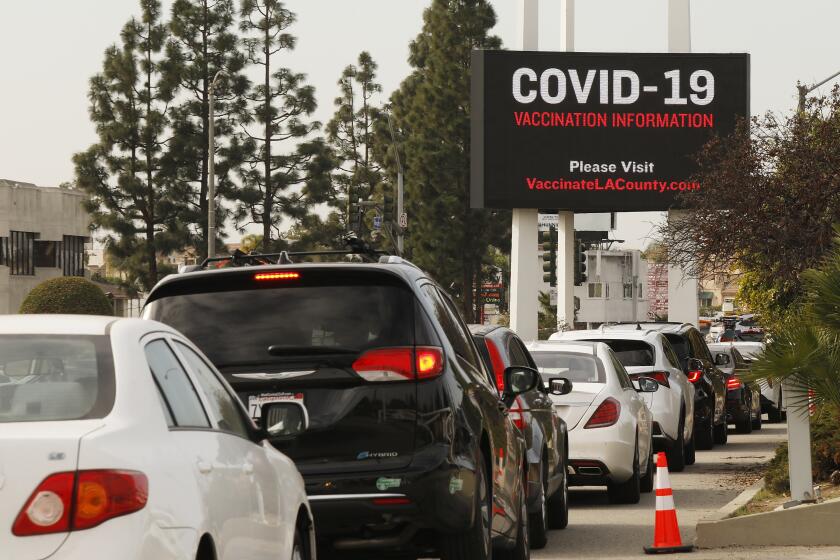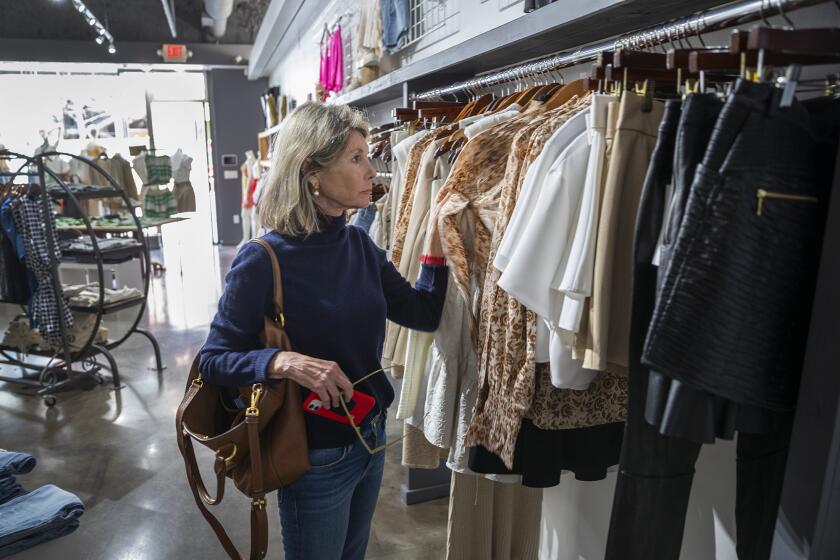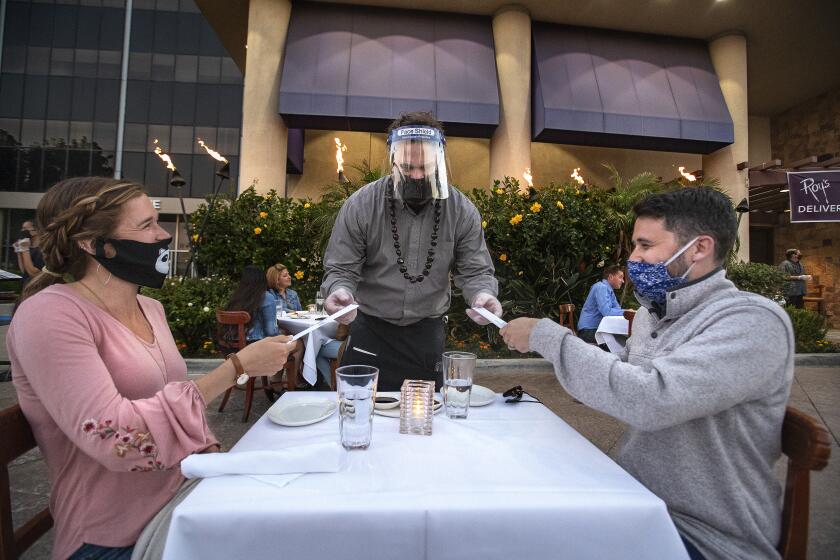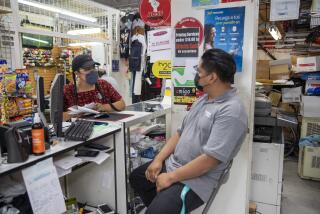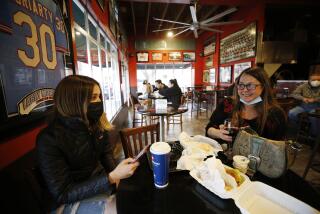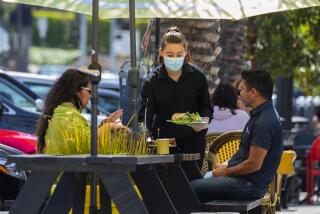Most California indoor dining rooms and gyms could reopen by next week
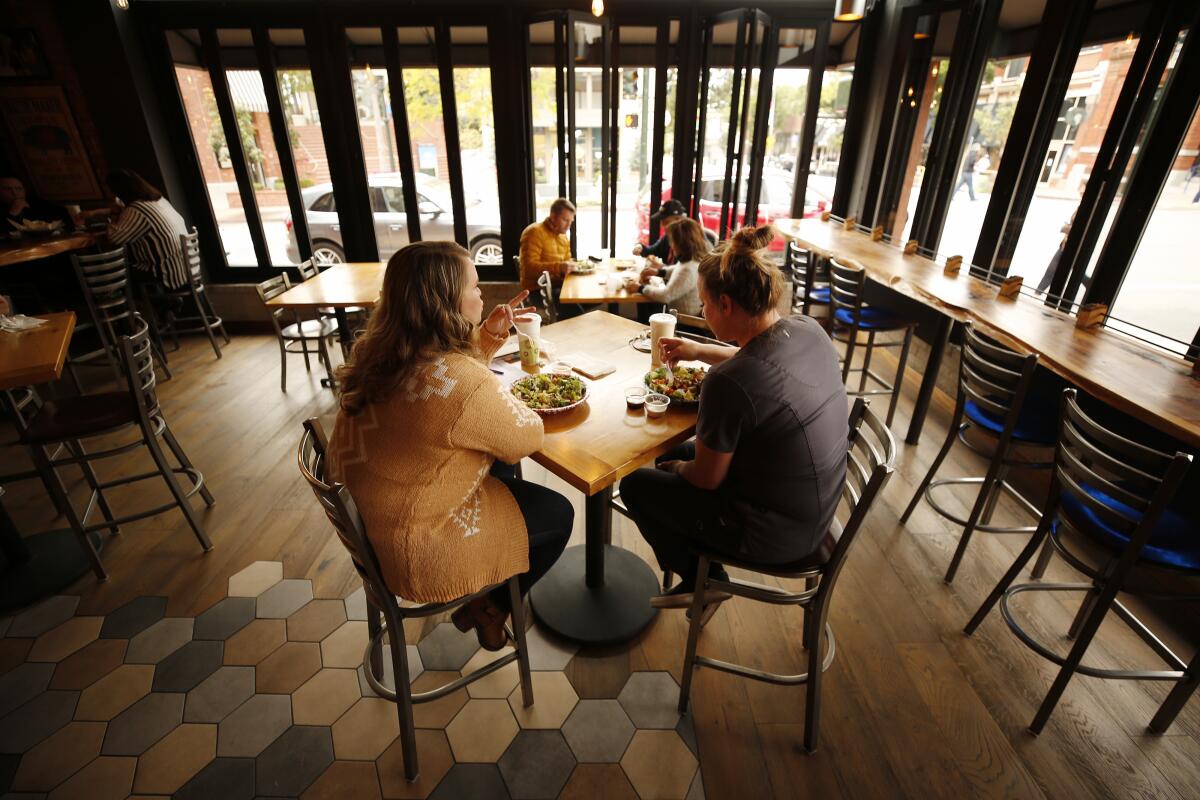
- Share via
Most California counties could find themselves out of the state’s strictest coronavirus closure tier within the next week, setting the stage for a wider economic reopening than has been seen in months, according to a Times data analysis.
The key to such a dramatic shift will be the state hitting its goal of administering 2 million COVID-19 vaccine doses to residents in its most disadvantaged areas, a hurdle Gov. Gavin Newsom said could be cleared by Friday.
When that happens, the state will relax the threshold necessary for counties to move from the most restrictive purple category of its four-tier reopening blueprint — where most counties have resided since the early days of the devastating fall-and-winter coronavirus wave.
Doing so would throw the door open for a dozen counties, including Los Angeles, Orange and San Bernardino, to advance to the less restrictive red tier as soon as this weekend, data show.
Southern California is poised to reopen its economy more widely, but the pace will be uneven as some counties move forward more quickly than others.
At this point, only two dozen counties — home to roughly 8 million Californians — are not in the purple tier.
Twenty are in the red tier; three have climbed from red to orange; and only one county, Alpine, has reached the most lenient yellow tier.
Most of those counties are in the Bay Area and on the Central Coast, the others in rural parts of Northern California and the Sierra Nevada. Much of Southern California and the Central Valley remain a purple splash on the state’s coronavirus canvas.
But once California hits its 2-million dose target, the state’s revised rules will allow counties to more easily and quickly exit the purple tier, clearing the way for even larger urban areas to begin unlocking additional activities and business operations, albeit still with modifications.
Counties that would be positioned to advance to red as soon as the state meets its goal are Los Angeles, Orange, San Bernardino, Contra Costa, Sonoma, Placer, Mendocino, San Benito, Tuolumne, Siskiyou, Colusa and Mono.
The process for getting a COVID-19 vaccine varies county to county.
Combined, those 12 counties have more than 17.7 million residents, accounting for 45% of the state’s population.
Should current trends continue, the following counties could be eligible to move from the purple to the red tier next week: San Diego, Riverside, Sacramento, Ventura, Tulare, Santa Barbara, Monterey, Sutter, Yuba, Lake and Tehama.
More than 9.7 million people live in these 11 counties. If they were to advance next week, that would swell the number of non-purple counties to 47, home to a combined 90% of the state’s population.
While the tier system takes into account several factors, including testing positivity rates and a health equity metric intended to ensure that the positivity rate in poorer communities is not significantly worse than the county’s overall figure, wider reopening hopes hinge on one aspect in particular: case rates.
Currently, counties must have a daily rate of new coronavirus cases — adjusted based on the number of tests performed — that is at or below 7.0 new cases per day per 100,000 people to move from purple to red.
After the state achieves its 2-million dose goal, however, counties with a case rate of up to 10.0 new cases per day per 100,000 people will become eligible for the red tier.
When reaching a threshold, counties need to log two consecutive weeks of sufficiently low case rates to advance. The only counties that wouldn’t be in position to move forward by next week, even under the revised criteria, are Fresno, Kern, San Joaquin, Stanislaus, Merced, Madera, Kings, Nevada, Amador, Glenn and Inyo.
A pair of studies in Science examine how coronavirus variants evolve in human hosts and why experts are concerned about relaxing restrictions too soon.
The changes in the tiering blueprint were announced as part of a wider effort aimed at addressing persistent inequities in vaccine administration.
California is now earmarking 40% of its available COVID-19 vaccines for residents in socioeconomically disadvantaged areas — a commitment officials said would both promote equity and buttress the state’s battle against the pandemic by ensuring ample supply is available for those workers and residents most at risk of being victims or vectors of the coronavirus.
Reaching the red tier, though still the second strictest of the four state categories, would permit counties to again allow indoor restaurant dining and movie theaters to reopen at 25% capacity or up to 100 people, whichever is less.
Red-level counties also can allow in-person classes to resume for students in grades 7 through 12. Indoor gyms and dance and yoga studios can open at 10% capacity. Museums, zoos and aquariums can open indoor activities at 25% capacity, and nonessential stores and libraries can open at 50% capacity, up from 25%.
Starting April 1, amusement parks also would be eligible to welcome back visitors, with restrictions, in that tier.
Though the new state rules are more permissive, local health officers still have the power to maintain restrictions if they feel they are warranted, meaning some counties could take a slower or more measured approach than what the state permits.
Restaurants, gyms, museums and movie theaters in Los Angeles County will be allowed to reopen for indoor activity, according to a public health order announced Thursday that marks the first major reopening of businesses since the start of the pandemic.
However, officials confirmed Thursday that L.A. County restaurants, gyms, museums and movie theaters will be cleared to reopen for modified indoor activity, once the state allows.
“It will be up to everyone, businesses and residents, to continue driving down transmission and to follow safety directives closely to keep everyone as safe as possible by preventing increases in cases,” Public Health Director Barbara Ferrer said in a statement. “When even relatively small numbers of businesses and individuals fail to adhere to the safety precautions, many others experience tragic consequences.”
But with coronavirus cases on the downswing and the number of vaccinated Californians on the rise, wider reopenings are continuing.
The California Department of Public Health announced a handful of additional changes Thursday, including that breweries, wineries and distilleries that do not serve meals will be allowed to resume modified outdoor operations across all tiers, starting Saturday.
In the purple and red tiers, patrons will need to make reservations and be subject to a 90-minute time limit, according to the latest state guidance, and onsite consumption must stop by 8 p.m.
Those businesses can begin to open indoors as their home counties progress further, though capacity will be limited to 25% or 100 people, whichever is fewer, in the orange tier; and 50% or 200 people, whichever is fewer, in the yellow tier.
Bars that don’t serve food remain closed for all operations in the purple and red tiers, but they can reopen outdoors with modifications in the orange tier. Effective Saturday, bars will be able to open indoors in yellow-tier counties, with capacity limited to 25% or 100 people, whichever is fewer.
More to Read
Sign up for Essential California
The most important California stories and recommendations in your inbox every morning.
You may occasionally receive promotional content from the Los Angeles Times.

